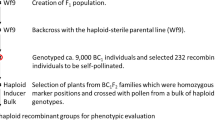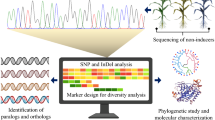Abstract
We report the accurate determination of the allelic configurations of a total of eight new citrus tetraploid hybrids by means of SSR analysis, coupled with capillary electrophoresis, and PCR based dosage effects. Tetraploid hybrids were spontaneously obtained from different interploid crosses (2x × 4x) between diploid ‘Femminello’ lemon and the allotetraploid somatic hybrid (2n = 4x = 36) ‘Key’ lime + ‘Valencia’ orange, and between diploid ‘Wilking’ and ‘Fortune’ mandarins and an autotetraploid ‘Dancy’ mandarin (2n = 4x = 36). To understand the opportunity to employ them in further backcross programs, the cytological mechanisms underlying their ploidy level were unambiguously determined using six SSR primers. PCR conditions were optimized and skewness in template/product ratios were verified. Tetraploid allelic configurations were determined from PCR based dosage effects using electropherogram peak heights to estimate the copy number per allele. In all the tetraploid hybrids we found out that diploginy (2n eggs) has occurred, contributing the extra haploid genome in the tetraploids. According to the marker genotypes, it was further inferred that the 2n eggs in ‘Femminello’ lemon resulted from first division restitution (FDR), while in ‘Wilking’ and ‘Fortune’ mandarins 2n eggs occurred in second division restitution (SDR). These new genotypes, with their improved genetic female background, can be therefore considered very valuable in our citrus genetic improvement program as pollen donors in backcrosses suitable to eliminate negative traits.



Similar content being viewed by others
References
Barcaccia G, Tavoletti S, Falcinelli M, Veronesi F (1997) Environmental influences on the frequency of meiotic and apomeiotic megasporogenesis in a diploid mutant of alfalfa. Crop Sci 37:70–76
Barkley NA, Roose ML, Krueger RR, Federici CT (2006) Assessing genetic diversity and population structure in a citrus germplasm collection utilizing simple sequence repeat markers (SSRs). Theor Appl Genet 112:1519–1531. doi:10.1007/s00122-006-0255-9
Barrett HC, Rhodes AM (1976) A numerical taxonomic study of affinity relationships in cultivated Citrus and its close relatives. Syst Bot 1:105–136
Bedi YS (1990) Cytomixis in woody species. Proc Indian Acad Sci (Plant Sci) 100:233–238
Bellucci M, Roscini C, Mariani A (2003) Cytomixis in pollen mother cells of Medicago sativa L. J Hered 94:512–516. doi:10.1093/jhered/esg096
Bretagnolle F, Thompson JD (1995) Gametes with the somatic chromosome number: mechanisms of their formation and role in the evolution of autopolyploid plants. New Phytol 129:1–22. doi:10.1111/j.1469-8137.1995.tb03005.x
Bretó MP, Ruiz C, Pina JA, Asins MJ (2001) The diversification of Citrus clementina Hort. Ex Tan., a vegetatively propagated crop species. Mol Phylogenet Evol 21:285–293. doi:10.1006/mpev.2001.1008
Burnham CR (1962) Discussions in cytogenetics. Burgess Publ. Co., St. Paul, MN
Buteler MI, LaBonte DR, Macchiavelli RE (1997) Determining paternity in polyploids: hexaploid simulation studies. Euphytica 96:353–361. doi:10.1007/s001220051216
Buteler MI, Jarret RL, LaBonte DR (1999) Sequence characterization of microsatellites in diploid and polyploid Ipomoea. Theor Appl Genet 99:123–132. doi:10.1007/s001220051216
Caruso M, Federici CT, Roose ML (2008) EST–SSR markers for asparagus genetic diversity evaluation and cultivar identification. Mol Breed 21:195–204. doi:10.1007/s11032-007-9120-z
Chen CL, Guo WW, Yi HL, Deng XX (2004) Cytogenetic analysis of two interspecific Citrus allotetraploid somatic hybrids and their diploid fusion parents. Plant Breed 123:332–337. doi:10.1111/j.1439-0523.2004.tb01827.x
Chen C, Lyon MT, O’Malley D, Federici CT, Gmitter J, Grosser JW, Chaparro JX, Roose ML, Gmitter FG Jr (2008) Origin and frequency of 2n gametes in Citrus sinensis × Poncirus trifoliata and their reciprocal crosses. Plant Sci 174:1–8. doi:10.1016/j.plantsci.2007.08.005
Cheng KC, Nieh HW, Yang CL, Wang IM, Chou IS, Chen JS (1975) Light and electron microscopial observations on cytomixis and the study of its relation to evolution. Acta Bot Sin 17:60–69
Comai L (2005) The advantages and disadvantages of being polyploid. Nat Rev Genet 6:836–846. doi:10.1038/nrg1711
Consiglio F, Carputo D, Monti L, Conicella C (2004) Exploitation of genes affecting meiotic non-reduction and nuclear restitution: Arabidopsis as a model? Sex Plant Reprod 17:97–105. doi:10.1007/s00497-004-0215-y
De Silva HN, Hall AJ, Rikkerink E, McNeilage MA, Fraser LG (2005) Estimation of allele frequencies in polyploids under certain patterns of inheritance. Heredity 95:327–333. doi:10.1038/sj.hdy.6800728
Doležel J, Binarová P, Lucretti S (1989) Analysis of nuclear DNA content in plant cells by flow cytometry. Biol Plant 31:113–120
Esen A, Soost RK (1971) Unexpected triploids in Citrus: the origin, identification and possible use. J Hered 62:329–333
Esen A, Soost RK (1972a) Aneuploid in Citrus. Am J Bot 59:473–477
Esen A, Soost RK (1972b) Tetraploid progenies from 2x × 4x crosses of Citrus and their origin. J Am Soc Hortic Sci 97:410–414
Esen A, Soost RK, Geraci G (1979) Genetic evidence for the origin of diploid mega-gametophytes in Citrus. J Hered 70:5–8
Esselink GD, Nybom H, Vosman B (2004) Assignment of allelic configuration in polyploids using the MAC-PR (microsatellite DNA allele counting-peak ratios) method. Theor Appl Genet 109:402–408. doi:10.1007/s00122-004-1645-s
Fang DQ, Roose ML (1997) Identification of closely related Citrus cultivars with inter-simple sequence repeat markers. Theor Appl Genet 95:408–417. doi:10.1007/s001220050577
Fang DQ, Roose ML, Krueger RR, Federici CT (1997) Fingerprinting trifoliate orange germplasm accessions with isozymes, RFLPs, and inter-simple sequence repeat markers. Theor Appl Genet 95:211–219. doi:10.1007/s001220050550
Fatta Del Bosco S, Mariani A (2004) Meiotic abnormalities in microsporogenesis of citrus genotypes. J Genet Breed 58:343–348
Fatta Del Bosco S, Tusa N, Conicella C (1999) Microsporogenesis in a Citrus interspecific tetraploid somatic hybrid and its fusion parents. Heredity 83:373–377. doi:10.1038/sj.hdy.6885770
Federici CT, Fang DQ, Scora RW, Roose ML (1998) Phylogenetic relationships within the genus Citrus (Rutaceae) and related genera as revealed by RFLP and RAPD analysis. Theor Appl Genet 94:812–822
Flajoulot S, Ronfort J, Baudouin P, Barre P, Huguet T, Huyghe C, Julier B (2005) Genetic diversity among alfalfa (Medicago sativa) cultivars coming from a breeding program, using SSR markers. Theor Appl Genet 111:1420–1429. doi:10.1007/s00122-005-0074-4
Geraci G, Esen A, Soost RK (1975) Triploid progenies from 2x × 2x crosses of Citrus cultivars. J Hered 66:177–178
Gottschalk W (1970) Chromosome and nucleus migration during microsporogenesis of Pisum sativum. Nucleus 13:1–9
Grosser JW, Moore GA, Gmitter FG Jr (1989) Interspecific somatic hybrid plants from the fusion of ‘Key lime’ (Citrus aurantifolia Swing) with ‘Valencia’ sweet orange (C sinensis O.) protoplast. Sci Hortic 39:23–29
Grosser JW, Ollitrault P, Olivares-Fuster O (2000) Somatic hybridization in citrus: an effective tool to facilitate variety improvement. In Vitro Cell Dev Biol 36:434–449. doi:10.1007/s11627-000-0080-9
Gulsen O, Roose ML (2001) Lemons: diversity and relationships with selected Citrus genotypes as measured with nuclear genome markers. J Am Soc Hortic Sci 126:309–327
Guochang Z, Quinglan Y, Yongren Z (1987) The relationship between cytomixis, chromosome mutation and karyotype evolution in lily. Caryologia 40:243–259
Julier B, Flajoulot S, Barre P, Cardinet G, Santoni S, Huguet T, Huyghe C (2003) Construction of two genetic linkage maps in cultivated tetraploid alfalfa (Medicago sativa) using microsatellite and AFLP markers. BMC Plant Biol 3:9
Kaul MLH, Murthy TGK (1985) Mutant genes affecting higher plant meiosis. Theor Appl Genet 70:449–466
Landergott U, Naciri Y, Schneller JJ, Holderegger R (2006) Allelic configuration and polysomic inheritance of highly variable microsatellites in tetraploid gynodioecious Thymus praecox agg. Theor Appl Genet 113:453–465. doi:10.1007/s00122-006-0310-6
Liu K, Goodman M, Muse S, Smith JS, Buckler E, Doebley J (2003) Genetic structure and diversity among Maize inbred lines as inferred from DNA microsatellites. Genetics 165:2117–2128
Luo ZW, Zhang Z, Zhang RM, Pandey M, Gailing O, Hattemer HH, Finkeldey R (2006) Modeling population genetic data in autotetraploid species. Genetics 172:639–646. doi:10.1534/genetics.105.044974
Luro F, Maddy F, Ollitrault P, Rist D (2000) Identification of 2n gamete parental origin and mode of nuclear restitution of spontaneous triploid Citrus hybrids. Proc Int Soc Citric 1:168–169
Murashige T, Tucker DPH (1969) Growth factor requirements of citrus tissue culture. Proc Int Soc Citric 3:1155–1161
Nicolosi E, Deng ZN, Gentile A, La Malfa S, Continella G, Tribulato E (2000) Citrus phylogeny and genetic origin of important species as investigated by molecular markers. Theor Appl Genet 100:1155–1166. doi:10.1007/s001220051419
Nybom H, Esselink GD, Werlemark G, Vosman B (2004) Microsatellite DNA marker inheritance indicates preferential pairing between two highly homologous genomes in polyploid and hemisexual dog-roses, Rosa L. Sect. Caninae DC. Heredity 92:139–150. doi:10.1038/sj.hdy.6800332
Omara MK (1976) Cytomixis in Lolium perenne. Chromosoma 55:267–271
Polz MF, Cavanaugh CM (1998) Bias in template-to-product ratios in multitemplate PCR. Appl Environ Microbiol 64:3724–3730. doi:0099-2240/98/$04.0010
Ramsey J, Schemske DW (1998) Pathways, mechanisms, and rates of polyploid formation in flowering plants. Annu Rev Ecol Syst 29:467–501
Scarano MT, Abbate L, Ferrante S, Lucretti S, Tusa N (2002) ISSR-PCR technique: a useful method for characterizing new allotetraploid somatic hybrids of mandarin. Plant Cell Rep 20:1162–1166. doi:10.1007/s00299-002-0450-3
Scarano MT, Tusa N, Abbate L, Lucretti S, Nardi L, Ferrante S (2003) Flow cytometry, SSR and modified AFLP markers for the identification of zygotic plantlets in backcrosses between ‘Femminello’ lemon hybrids (2n and 4n) and a diploid clone of ‘Femminello’ lemon (Citrus limon L. Burm. F.) tolerant to mal secco disease. Plant Sci 164:1009–1017. doi:10.1016/s0168-9452(03)00088-8
Scora RW (1975) On the history and origin of Citrus. Bull Torrey Bot Club 102:369–375
Soost RK, Roose ML (1996) Citrus. In: Jules J, Moore JN (eds) Fruit breeding: tree and tropical fruits, vol 1. Wiley, New York, pp 257–323
Starrantino A, Reforgiato-Recupero G (1981) Citrus hybrids obtained in vitro from 2X females × 4X males. Proc Int Soc Citric 1:31–32
Suzuki M, Giovannoni SJ (1996) Bias caused by template annealing in the amplification mixtures of 16S rRNA genes by PCR. Appl Environ Microbiol 62:625–630. doi:0099-2240/96/$04.0010
Swingle WT, Reece PC (1967) The botany of Citrus and its wild relatives. In: Reuther W, Webber HJ, Bachelor LD (eds) The Citrus industry, vol 1. University of California Press, Berkeley, pp 190–430
Truong C, Palme AE, Felber F, Naciri-Graven Y (2005) Isolation and characterization of microsatellite markers in the tetraploid birch, Betula pubescens ssp. tortuosa. Mol Ecol Notes 5:96–98. doi:10.1111/j.1471-8286.2004.00848
Tusa N, Grosser JW, Gmitter FG Jr (1990) Plant regeneration of Valencia sweet orange, Femminello lemon, and interspecific somatic hybrid following protoplast fusion. J Am Soc Hortic Sci 115:1043–1046
Tusa N, Grosser JW, Gmitter FG Jr, Louzada ES (1992) Production of tetraploid somatic hybrid breeding parent for use in lemon cultivar improvement. HortScience 27:445–447
Tusa N, Fatta Del Bosco S, Nardi L, Lucretti S (1996) Obtaining triploid plants by crossing Citrus lemon cv. ‘Femminello’ 2n × 4n allotetraploid somatic hybrids. Proc Int Soc Citric 1:133–136
Tusa N, Abbate L, Ferrante S, Lucretti S, Scarano MT (2002) Identification of zygotic and nucellar seedlings in citrus interploid crosses by means of isozymes, flow cytometry and ISSR-PCR. Cell Mol Biol Lett 7:703–708
Veilleux RE (1985) Diploid and polyploid gametes in crop plants: mechanisms of formation and utilization in plant breeding. Plant Breed Rev 3:253–288
Viloria Z, Grosser JW, Bracho B (2005) Immature embryo rescue, culture and seedling development of acid citrus fruit derived from interploid hybridization. Plant Cell Tissue Organ Cult 82:159–167. doi:10.1007/s11240-005-0153-x
Wagner A, Blackstone N, Cartwright P, Dick M, Misof B, Snow P, Wagner GP, Bartels J, Murtha M, Pendleton J (1994) Surveys of gene families using polymerase chain reaction: PCR selection and PCR drift. Syst Biol 43:250–261
Webb DM, Knapp SJ (1990) DNA extraction from a previous recalcitrant plant genus. Plant Mol Biol Rep 8:180–185
Author information
Authors and Affiliations
Corresponding author
Additional information
Contribution n. 341 from CNR-IGV, Institute of Plant Genetics, Research Division: Palermo.
Rights and permissions
About this article
Cite this article
Ferrante, S.P., Lucretti, S., Reale, S. et al. Assessment of the origin of new citrus tetraploid hybrids (2n = 4x) by means of SSR markers and PCR based dosage effects. Euphytica 173, 223–233 (2010). https://doi.org/10.1007/s10681-009-0093-3
Received:
Accepted:
Published:
Issue Date:
DOI: https://doi.org/10.1007/s10681-009-0093-3




